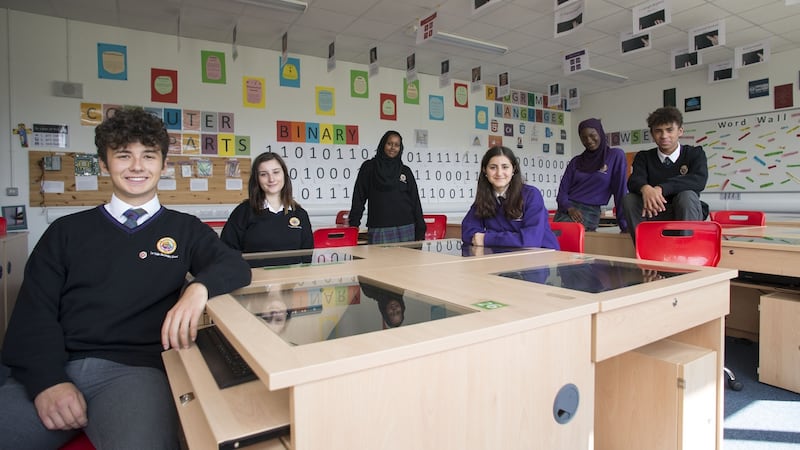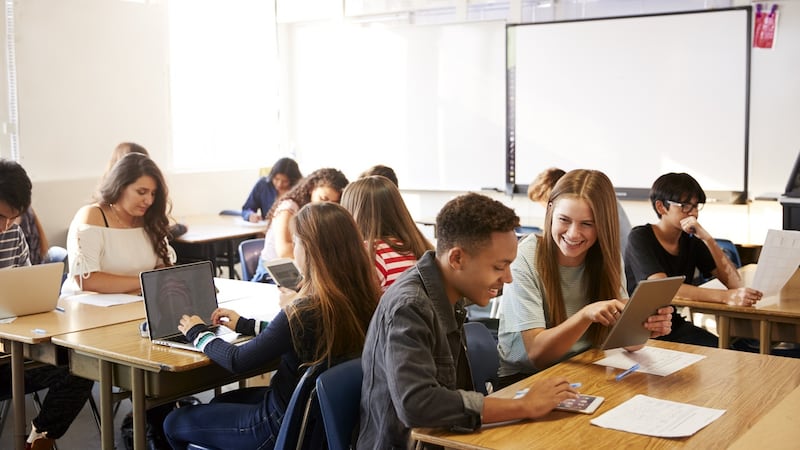During the general election, a suggestion by the Green Party caught the attention of many hard-pressed parents: getting rid of homework.
The case against homework is strong, with research consistently showing it is, at best, pointless and, at worst, damages children by eating into their play time. Could the flipped classroom be a third way?
Flipped classrooms seem like a relatively straightforward concept: students do the learning at home, usually by watching instructional videos, and then work on problem-solving and discussion in class.
A review of studies found that only about 15 per cent reported a positive impact on student engagement, although half of the studies report students get higher grades
Advocates say it benefits students who learn at different paces and frees up time for teachers and lecturers to help those who might otherwise fall behind.
Critics say that it can be hard to get students on board and claim that the flipped classroom model benefits students from families with more resources.
The Irish Times spoke to around a dozen educators at primary, secondary and third level to get their views on whether flipped classrooms should bounce into our schools and colleges – or whether they ought to flip off.
Research
Much of the research on flipped classrooms is focused on third level. A 2018 survey by the European Universities Association found that fewer than one in seven European universities found the model useful, while a more recent – and contested – study by the Massachusetts Institute of Technology threw cold water on the idea that flipped classrooms boost student performance.
And a review of studies carried out in 2018 found that only about 15 per cent reported a positive impact on student engagement, although half of the studies report students get higher grades in the flipped classroom.
Rita Treacy is a qualified speech and language therapist and director of Wordsworth Learning, which runs a specific literacy programme for primary school children using a flipped model.
“Children learn at different paces, or may miss classes if they’re sick, playing sports or taken out for learning support, and they don’t have sufficient time to practise and consolidate their learning,” she says.
“Flipped classrooms can be good for neurodiverse children who can pause, replay and learn at their own pace. ‘Homework’ is given in class, which allows the teacher to gain a better understanding of learning styles and gently picks up the students who are having difficulty.”
Treacy injects a note of caution, however. “The material has to be focused, clear and concise and, ideally interactive: if it’s just a video, students are at the mercy of how good or bad the material is. And there needs to be clear session plans. We’re very aware of attention spans, so Wordsworth has been developed around short instructional videos. The parent’s role is as facilitator and monitor, to make sure the child is actively engaging.”

Whim
Le Chéile, a secondary school in Tyrellstown, Dublin 15, uses iPads and some degree of flipped learning. Áine Moran, founding principal of the school and currently on secondment as leadership and ethos officer of the Le Chéile schools, agrees that schools can’t simply bring in flipped learning on a whim.
“Our teachers make their own videos,” she explains. “These videos contain some key questions and students will be asked what they could and could not follow.
“In school the next day, the children have already differentiated themselves. I can give ‘homework’ to students who can fly ahead, and then give more focused or one-on-one attention to others. Nobody is at home upset that they can’t do the homework. While there may be more work for teachers in setting it up, they do enjoy the chance for uninterrupted teaching, and they can hit all the buttons they want in a particular lesson.”
'Flipped learning should not place additional demands on students' time and, where used, needs to be factored into the contact and study hours'
Flipped learning has its limitations, Moran says. “Sometimes watching a video is your homework, but I wouldn’t use it all the time. In my own subject, business studies, it’s useful for book-keeping but less so for marketing. I can see a particular value in science, technology, engineering and maths subjects.”
Third level
It's at third level, however, where most of the action is taking place. Various higher education institutions are experimenting with the concept, including Dublin City University (DCU), Trinity, the National College of Ireland (NCI) and Dublin Business School (DBS).
Dr Eimear Long, a law lecturer at DBS, says that she posts documents, screencasts, podcasts and online activities on Moodle (a virtual learning environment) as part of a partially flipped approach.
“Students are expected to cover this material in their own time in advance of class, with the class then focusing on the application of that knowledge. It’s a good model for introducing variety in methods of presenting materials and developing skills,” she says.
Frances Sheridan, a lecturer at the school of computing in NCI, has presented on this topic at international conferences. She says that flipped classrooms work best with another pedagogy.
In one module, she combines it with problem-based learning; in another, she employs more traditional teaching methods to help students learn “how to learn” from online video content. “In order for it to work, all stakeholders must be on board. I tweaked and changed my approach through the semester.”
Dr Ciara O’Farrell is head of academic practice in Trinity, where flipped learning approaches have been trialled in some modules.
'I would worry that students who are not well-off, working outside college and commuting long distances are under pressure to more work at home'
“Flipped learning should not place additional demands on students’ time and, where used, needs to be factored into the contact and study hours,” she says.
“One of the biggest challenges is getting buy-in from the students, so it needs to be underpinned by strong pedagogy and data analytics tools. And it can be especially useful where a subject doesn’t have tutorials.”
Dr Mark Glynn, head of the teaching enhancement unit at DCU, agrees that flipped learning needs to be carefully implemented, but says that it frees up more time for deeper understanding.
“You lead with the teaching, not the technology. But a ten minute video takes more than ten minutes to make and that’s why we want lecturers to work with units like ours before changing to flipped learning. It needs continuous professional development and proper training for staff.”

Flip off
Greg Foley, associate professor of biotechnology at DCU, is sceptical about the flipped learning model, as are a number of teachers who contacted this journalist via Twitter.
“My students were not buying into flipped learning,” he says. “Being a college student these days involves a lot of continuous assessment and semesterised exams, and flipped learning is enforcing a study pattern on them when they should have more control and freedom over their own destiny. I would also worry that students who are not well-off, working outside college and commuting long distances are under pressure to more work at home.”
Foley says that there can be a “cult of innovation” in education, but he has not seen convincing evidence that the familiar model needs change.
His view is supported by Daisy Christodoulou, director of UK-based No More Marking and author of the forthcoming book Teachers vs Tech.
"I'm in favour of evidence-based education technology, but there can be a view in education that we don't need facts anymore because we have smartphones and Google and that it should be all about how to think," she says.
“This neglects that, even without fake news, we have limited working memories and we need facts in our long-term memory to be able to think.”
She feels flipped learning can be effective, and many teachers have seen the pitfalls and worked around them, but there is a danger of students developing misconception and making mistakes and errors.







